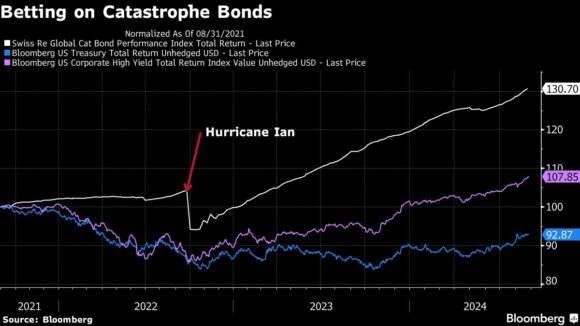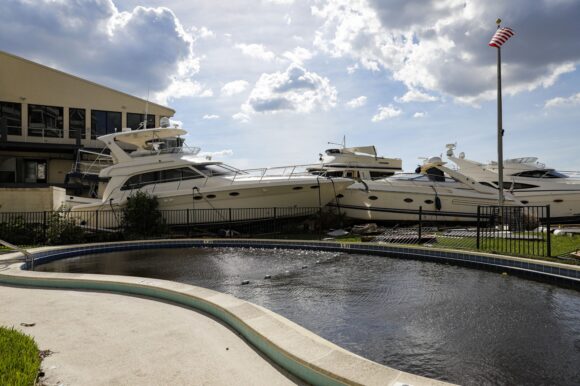Fermat Capital Management, one of the world’s biggest investors in catastrophe bonds, says anxiety about this year’s hurricane season has already left a meaningful dent on returns.
“Returns in May were low and even negative for a lot of funds,” Brett Houghton, managing director at Fermat, said in an interview. “Widespread fears about a particularly severe hurricane season meant there was a lot of selling pressure in the secondary market.”
The hedge fund manager, who helps oversee about $9.5 billion in assets, said Fermat’s returns for the first six months of the year were “in line” with the 5.8% advance of the Swiss Re Global Cat Bond Performance Index. That’s roughly half the index’s 10.5% return during the same period last year.
After more than 18 months of uninterrupted gains, the cat bond market was hit by a selloff in the second quarter as investors reacted to meteorologists predicting one of the most active hurricane seasons in recent memory. In May, the Swiss Re index dipped about 0.5%, marking its first monthly decline since Hurricane Ian made landfall in September 2022.
For now, though, cat bond investors have been spared large losses. Hurricane Beryl, which ripped through the Caribbean and into Texas last month, didn’t reach the precise levels of air pressure that would have triggered payment clauses and required investors to help cover losses.
Cat bonds are issued by insurers, reinsurers and governments who want an additional layer of coverage for extreme weather events such as once-in-a-generation hurricanes. Investors face potentially substantial losses if a bond is triggered, but can generate market-beating returns if a predefined catastrophe doesn’t occur.
Cat bonds underpinned the best hedge-fund strategy of 2023, with insurance-linked securities overall delivering more than 14% on an annualized basis, based on data provided by Preqin for the first nine months of last year.
As a strategy, ILS has slipped considerably in the rankings, with Preqin now putting it at eighth place in the 12-month period ended June 30. That said, cumulative returns tied to ILS were still 12% in that time frame. The best hedge fund strategy — called “opportunistic” — delivered 19%, Preqin reported.
The market for cat bonds “is still relatively firm and still offers attractive returns,” said Toby Pughe, a London-based analyst at Tenax Capital. The asset manager’s euro-denominated UCITS cat bond fund returned about 4% in the first half, he said.
In a recent report, Fitch analysts Brian Schneider and Manuel Arrive said the expectation is of “continued strong supply growth in the alternative reinsurance capital market into 2025, barring substantial ILS catastrophe losses” in the second half of this year.

Portfolio strategies involving cat bonds have traditionally been viewed as too complex for all but the savviest of fund managers. But the securities have started to attract more mainstream investors, drawn by the possibility of hefty returns that aren’t correlated with the wider market. It’s a development that’s starting to affect price dynamics.
In the first quarter, there was “an overzealous bid for bonds,” said Jeffrey Davis, partner and portfolio manager at Elementum Advisors, a Chicago-based investor. “This bid then became the main detractor of second-quarter performance as demand abruptly reversed course.”
Meanwhile, the supply of the bonds is up, with issuers seeking additional coverage. That’s as regulators warn that the insurance sector won’t be able to cover the losses ahead without turning to capital markets.
Sophie Ware, a managing director at Neuberger Berman, says primary issuance of cat bonds has already topped $12 billion this year, making it “extremely likely” that it will be a “record-breaking year.” The additional supply “has also resulted in a deeper market with more active secondary market trading in 2024,” she said.
Trading in the secondary market for cat bonds rose 75% to $2.8 billion in the first half of 2024 from a year earlier, according to estimates provided by Elementum.
Investors are still waiting to see how the 2024 hurricane season develops, with peak activity expected between mid-August and mid-October, according to the US National Hurricane Center. If a major storm makes landfall in a densely populated area, it could lead to price volatility and wider spreads.
Pughe of Tenax notes that it’s normal to see some tightening in the cat bond market when hurricane season gets underway. But there’s “no room for complacency,” he said.
And Houghton says Fermat is “not taking any comfort” just because Beryl didn’t trigger losses.
“There’s a lot more of the season to come,” he said.
Photograph: Yachts piled along the shore following Hurricane Ian in Fort Myers, Florida, on Oct. 3, 2022. Photo credit: Eva Marie Uzcategui/Bloomberg
Topics Catastrophe
Was this article valuable?
Here are more articles you may enjoy.



 Group Sues California Department of Insurance Over FAIR Plan Surcharges
Group Sues California Department of Insurance Over FAIR Plan Surcharges  South Florida Insurance Broker Pleads Guilty to Fraud in $133M ACA Enrollment Scheme
South Florida Insurance Broker Pleads Guilty to Fraud in $133M ACA Enrollment Scheme  Global Q1 Commercial Insurance Rates Drop 3%, but US Casualty Bucks the Trend
Global Q1 Commercial Insurance Rates Drop 3%, but US Casualty Bucks the Trend  Florida Bill Advances, Would End Board of Engineers, Other Professional Agencies
Florida Bill Advances, Would End Board of Engineers, Other Professional Agencies 

